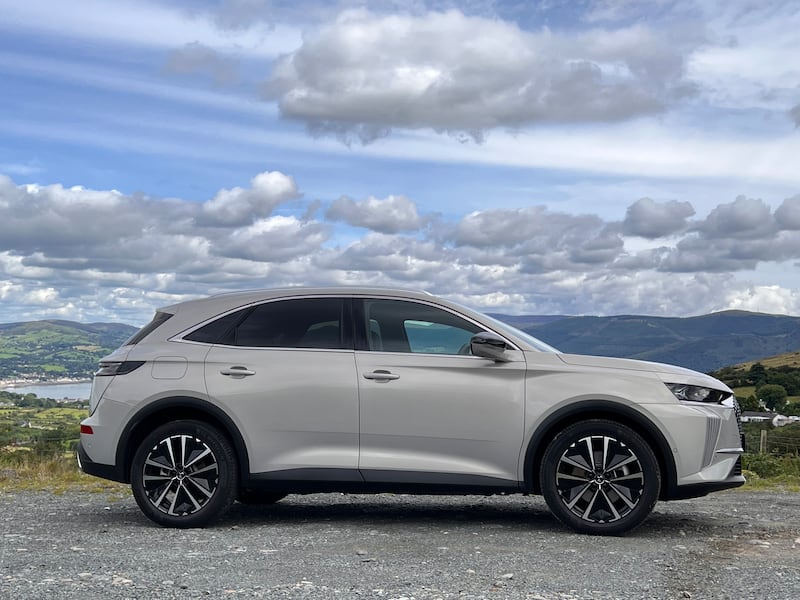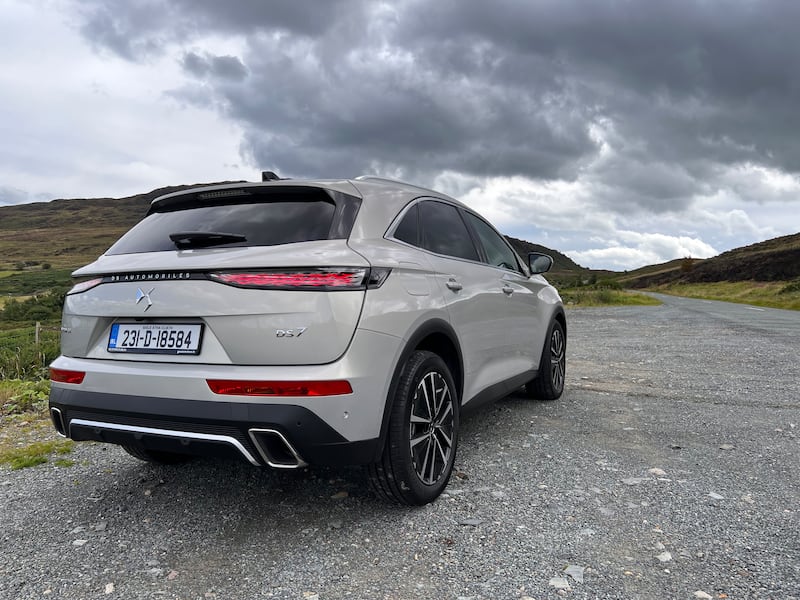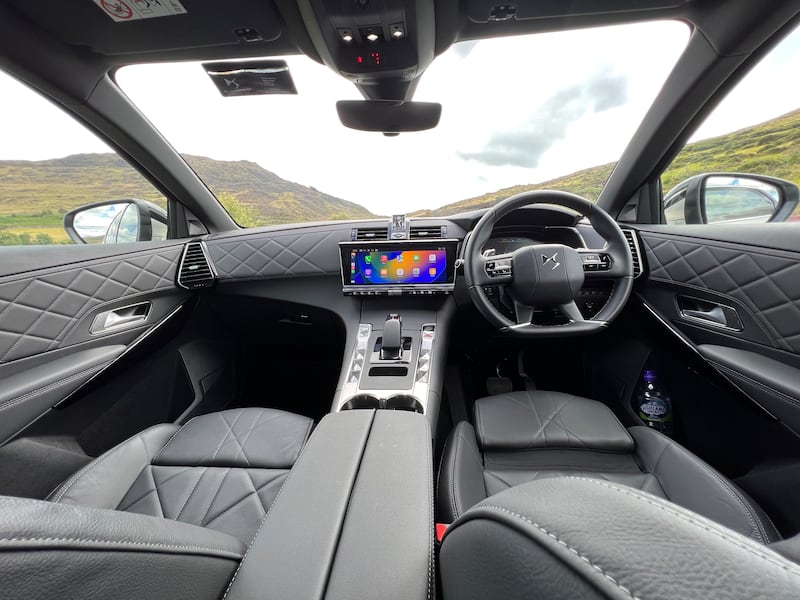As Jean Paul Sartre, that troublesome doyen of French philosophy put it, “existence precedes essence”. That certainly seems to be the case for the DS 7.
This is a car which has been around for quite a while now, without ever seemingly figuring out quite what it wants to be. Is it a rival for the BMW X1 or the BMW X3? Because in terms of price and size, it’s kind of both.
Is it a direct competitor to the sort of sharp-steering, hard-riding German SUV that has become so popular? Or is it a traditional French luxury car, in the mould of its great Citroen DS ancestor, all floaty comfort? Because it seems to be trying to do both, and succeeding at neither. The DS 7 is a car which has existed since 2017, but it, as far as I can tell, has not yet found its essence.
Nonetheless, in the interests of continuing that existence, DS has updated and upgraded the 7, ditching the old Crossback subtitle. Up front, you’ll find new curtain-like LED daytime running lights, which seem to shine through the bodywork rather than being attached to it. There are also new Pixel LED headlights, which seem bright enough to light up the entire Paris Opera, should you wish to. There is a revised boot, which now includes the DS Automobiles badge, proudly spelled out – probably just so your average punter can work out what it is.
A New Zealander in Dublin: ‘It feels like people work to live here as opposed to living to work’
Family fallouts: ‘I can’t describe the heartache of not having a relationship with my sister’
Zach Bryan in Dublin review: Gen Z’s Garth Brooks puts on a charming – and lengthy – show
How the death of an ‘old boy from Ireland’ in London-Irish suburb sparked a misguided viral appeal

And that is a difficult task, one which would have taxed the minds of Descartes and Camus. You see, DS, as a brand, finds itself in an awkward position. It’s named for the 1955 Citroen DS, a sleek, slinky, frankly sexy four-door saloon that lays as good a claim as any to being the greatest car ever built. Citroen being Citroen managed to lose money on it, and so 50 years later decided that what it needed was not a posh DS model, but a whole DS brand, something that could be a rival to the hegemony of German premium brands.
this DS 7 range now includes a high-performance model, using the four-wheel-drive 360hp plug-in hybrid power-train from the Peugeot 508 PSE. For… reasons, we suppose
To say that it’s been a difficult journey from there is quite the understatement, and it’s not been helped by the merger with the Fiat-Chrysler Automobiles group, creating the Stellantis conglomerate, because that means that DS must share premium-badge shoulder room with Alfa Romeo and Maserati.
So, it would seem that the obvious thing to do would be to turn DS into the anti-performance luxury model. Forget trying to compete with the Germans on steering feel and high-speed cornering, and instead give it floaty, pillowy suspension and seats like sofas, just like that original DS.
Er, no – that’s not what DS has done. In fact, this DS 7 range now includes a high-performance model, using the four-wheel-drive 360hp plug-in hybrid power-train from the Peugeot 508 PSE. For… reasons, we suppose.
Hybrid set-up
Our test car was not that. It was the front-wheel drive 225hp plug-in hybrid E-Tense model, which mixes a 1.6-litre turbo petrol four-cylinder engine with a rechargeable battery that is supposed to get you as much as 69km of electric motoring on one charge. It will do that, or close enough – we were seeing between 40 and 50km of available range, depending on where and when we were driving – but the rest of the hybrid set-up is not a happy one.

This is an issue we’ve noticed with other Stellantis Group models using this system, and it basically lacks the ability to harmoniously switch between petrol power, electric power, and a mixture of the two. The automatic transmission seems unsure of itself, quelling acceleration as you start to put your foot down, and then suddenly jumping down two gears or more, allowing the engine to rev unexpectedly and loudly, as you make jerky progress up the road, The likes of Lexus and Volvo have PHEV set-ups that are far, far smoother and quieter than this.
At least long-range fuel economy is okay. You should average around 7.0 litres per 100km on a long run, but that’s beaten by the 5.3 litres per 100km we averaged in a Toyota RAV4 PHEV on the same route.
There are further issues when it comes to the chassis. DS has clearly fudged the decision of whether to be sharp or comfortable, and it ends up being not sharp enough and not quite comfortable enough. Our pricey Rivoli-spec test car (all €63,000 of it) included a camera system that scans the road ahead for bumps, warning the adaptive suspension dampers of what’s coming up, but even then there’s an underlying firmness to the ride, and clonky responses when those 19-inch alloys hit a bump or pothole.
It’s reasonably pleasant to drive, if you can ignore the stumblings of the hybrid system, and it has a very nice cabin. It’s also roomy and practical
At least it settles down on the motorway, and then you can start to enjoy the cabin, which is a high point.

Overall quality is fine, although not quite as solid in feel as that of a Mercedes or Audi. The quilted leather on the doors and seats is almost Bentley-like, and the new pair of 12.3-inch digital screens – one for instruments, one for infotainment – are both excellent. Space is good, and the front seats are wonderfully comfortable. The only downside seems to be DS’s decision to make all of its interior buttons and switches so awkward to find, and so similar in style, but you do get used to it.
So, the DS 7, in this upgraded and updated form, is a decent premium SUV. It’s reasonably pleasant to drive, if you can ignore the stumblings of the hybrid system, and it has a very nice cabin. It’s also roomy and practical, and if you plug it in every night, religiously, then you should get very good electric range and overall economy out of it.
However, what it makes up in existence, it lacks in essence. It still feels like a car from a brand that’s finding its feet, and trying to work out what makes a DS a DS. Until it does that, the DS 7 is at best going to be a pleasant alternative, rather than a true rival, to the Germans.
Lowdown: DS 7 225 E-Tense Rivoli
Power: 1.6-litre four-cylinder turbocharged petrol engine, plus an electric motor and 14.2kWh battery pack developing 225hp and 320Nm powering the front wheels via an eight speed automatic transmission.
CO2 emissions (annual motor tax) 28g/km (€140).
Electric range: 69km (WLTP)
Fuel consumption: 1.6l/100km (WLTP)
0-100km/h: 8.9 secs.
Price: From €51,785 (€63,895 as tested)
Our rating: 3/5.
Verdict: Not a bad car as such, but a car seemingly still searching for what it’s supposed to be.











